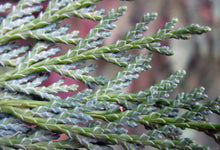
Chamaecyparis lawsoniana
Due to its relatively narrow, pyramidal form, Port Orford or Lawson's cedar can make an excellent overstory tree for large yards. Its evergreen, scale-like foliage can range from bright-green to waxy pale blue and forms pleasantly-fragrant, drooping sprays. The cones are small, appearing green at first, with pink pollen tips in spring, and becoming brown as they mature in the fall. In the residential garden, it typically reaches heights of 40-80 feet but in the wild, it can be huge and extremely long-lived, clocking in at up to 200 feet tall and 600 years old! Like most overstory, evergreen trees, this species is highly attractive to wildlife.
- Plant type/canopy layer: evergreen, perennial, large tree
- Size at maturity: 40-80' tall in gardens, up to 200’ in the wild; up to 30' wide
- Light requirements: full sun to partial shade
- Moisture requirements: moist soil, must be well-drained
- Bloom time: March - April (pink pollen cones on branch tips)
- Growth rate/ease: medium growth rate, easy to grow
- Wildlife support: favored by many songbirds for roosting, providing high cover and especially for nesting; also a caterpillar host plant and larval food source for native butterflies and/or moths
- Native habitat/range: grows in mountain valleys, often along streams in Douglas-Fir and mixed-evergreen forests, from sea level up to 1500 meters. In southwest Oregon and northwest California, it is especially common in the Coast Range but occasionally found inland in the Siskiyou Mountains and on Mt. Shasta. Portland Plant List - no.
- Special features & uses: evergreen; deer resistant; landscape uses include woodland garden, erosion control, and habitat hedgerow; highly-valued for its wood, which is strong and both rot and insect-resistant, so it was historically used in many contexts such as coffins, arrow shafts, stringed instruments and ships
Gardening with Port Orford Cedar: This large tree is perfect as a specimen plant or for hedges and screens in larger sites, where it can freely live out its long life and achieve its full form. Its ideal preference would be partial sun, though it can tolerate full sun provided the soils are moist enough. In addition to being relatively moist, soils should be neutral to slightly acidic and well-drained, such as sandy and clay loams and rocky ridges, as it is highly susceptible to root rot. Though it can be tolerant to drought, it would also appreciate deep infrequent watering, about twice per month, during the summer drought. Dead branches may be pruned in winter when wood-boring insects are less active. Avoid cutting into living wood.
Photo Credits 1 & 5: © Matt Berger, some rights reserved (CC-BY)
Photo Credit 2: © David Ashcroft, some rights reserved (CC-BY)
Photo Credit 3: © marek, some rights reserved (CC-BY)
Photo Credit 4: "Chamaecyparis lawsoniana pollen cones 03" by Amada44 is licensed under CC BY 3.0.
Photo Credit 6: © Ryan Elliott, some rights reserved (CC-BY)











